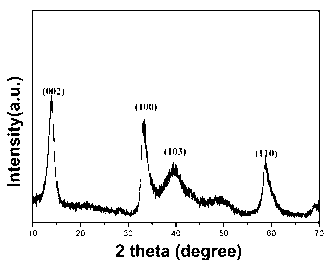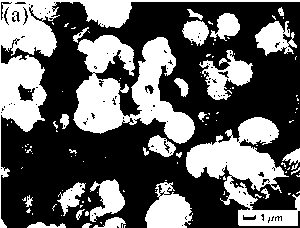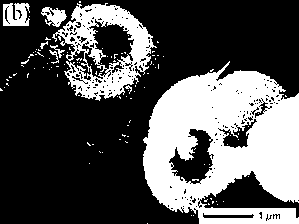Preparation method for molybdenum disulfide nanometer nuclear shell nano-structure
A nano-core-shell and nano-structure technology, applied in the field of nanomaterials, can solve the problems of harsh reaction conditions, difficult to control morphology, and high cost, and achieve the effects of high product difference rate, simple and easy-to-control production process, and low cost.
- Summary
- Abstract
- Description
- Claims
- Application Information
AI Technical Summary
Problems solved by technology
Method used
Image
Examples
Embodiment 1
[0020] 0.88g Na 2 MoO 4 2H 2 O, 0.94g Na 2 S, and 0.41 g of ascorbic acid were added to 60 ml of ethanol-water (2:1) mixed solvent, dissolved to obtain a clear solution, and then 0.30 g of C 27 h 50 After ClN is completely dissolved, use 2mol·L -1 The pH value was adjusted to 12 with NaOH, and after stirring for 30 min, the mixture was transferred to a 100 ml stainless steel reactor, placed in a vacuum oven at 180°C for 36 h, cooled to room temperature, and the reaction product was centrifuged. Repeated washing with deionized water and absolute ethanol, respectively, and finally drying at 80 °C for 10 h under vacuum to obtain a gray-black product powder, that is, molybdenum disulfide nano-core-shell nanostructure.
[0021] figure 1 The XRD pattern shows that the XRD peak position is consistent with the standard diffraction pattern (PDF No.37-1492), and the product is pure MoS 2 Nano-structure, figure 2 It is a low-magnification SEM photo of the product, a large number...
Embodiment 2
[0023] 1.21g Na 2 MoO 4 2H 2 O, 1.36g Na 2 S, and 1.76g of ascorbic acid were added to 60 ml of ethylene glycol-water (2:1) mixed solvent, dissolved to obtain a clear solution, and then 0.27 g of C 27 h 50 After ClN is completely dissolved, use 2mol·L -1 The pH value was adjusted to 14 with NaOH, and after stirring for 30 min, the mixture was transferred to a 100 ml stainless steel reaction kettle, placed in a vacuum oven at 160 °C for 48 h, cooled to room temperature, and the reaction products were separated by centrifugation. Repeated washing with deionized water and absolute ethanol, and finally drying at 80°C for 10 h under vacuum conditions to obtain a gray-black product powder, that is, molybdenum disulfide nano-core-shell nanostructure, the XRD pattern and SEM photo of Example 2 are similar to Examples 1.
Embodiment 3
[0025] 0.73g Na 2 MoO 4 2H 2 O, 0.59g Na 2 S, and 1.06 g of ascorbic acid were added to 60 ml of ethylene glycol-water (2:1) mixed solvent, dissolved to obtain a clear solution, and then 0.32 g of C 27 h 50 After ClN is completely dissolved, use 2mol·L -1 The pH value was adjusted to 13 with NaOH, and after stirring for 30 min, the mixture was transferred to a 100 ml stainless steel reactor, placed in a vacuum oven at 200 °C for 24 h, cooled to room temperature, and the reaction products were separated by centrifugation. Repeated washing with deionized water and absolute ethanol, and finally drying at 80°C for 10 h under vacuum conditions to obtain a gray-black product powder, that is, molybdenum disulfide nano-core-shell nanostructure, the XRD pattern and SEM photo of Example 3 are similar to Examples 1.
PUM
| Property | Measurement | Unit |
|---|---|---|
| Diameter | aaaaa | aaaaa |
| Thickness | aaaaa | aaaaa |
| Diameter | aaaaa | aaaaa |
Abstract
Description
Claims
Application Information
 Login to View More
Login to View More - R&D
- Intellectual Property
- Life Sciences
- Materials
- Tech Scout
- Unparalleled Data Quality
- Higher Quality Content
- 60% Fewer Hallucinations
Browse by: Latest US Patents, China's latest patents, Technical Efficacy Thesaurus, Application Domain, Technology Topic, Popular Technical Reports.
© 2025 PatSnap. All rights reserved.Legal|Privacy policy|Modern Slavery Act Transparency Statement|Sitemap|About US| Contact US: help@patsnap.com



